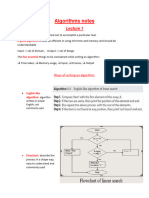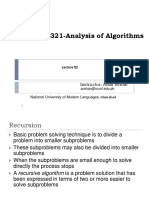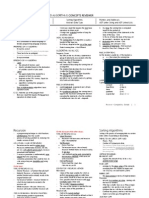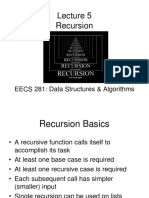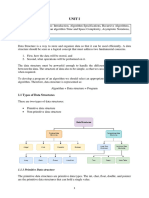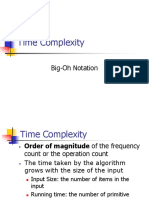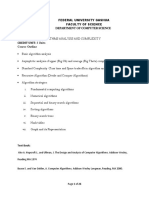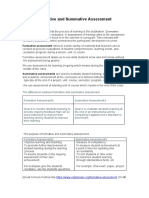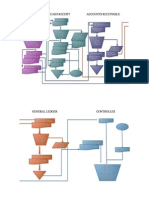Introduction to Algorithms
1. What is an Algorithm?
o An algorithm is a well-defined sequence of steps or instructions to solve a specific
problem or perform a task.
o It serves as the foundation for computer programming and problem-solving.
2. Characteristics of Algorithms:
o Finiteness: Must terminate after a finite number of steps.
o Definiteness: Each step must be clearly defined and unambiguous.
o Input and Output: Takes zero or more inputs and produces at least one output.
o Effectiveness: Each operation must be basic enough to be executed.
3. Applications of Algorithms:
o Sorting and searching (e.g., Bubble Sort, Binary Search).
o Graph processing (e.g., Dijkstra’s Algorithm for shortest paths).
o Data compression and encryption.
4. Why Study Algorithms?
o To develop efficient software systems.
o To optimize resources such as time and memory.
o To address complex real-world problems systematically.
Asymptotic Notations
1. Purpose of Asymptotic Analysis:
o Evaluate the efficiency of an algorithm in terms of time and space.
o Focus on growth trends as input size increases, ignoring hardware or software
constraints.
2. Types of Asymptotic Notations:
o Big-O Notation (O):
Represents the worst-case upper bound.
Describes the maximum time or space an algorithm will take.
Example: Linear Search has O(n) complexity.
o Omega Notation (Ω):
Represents the best-case lower bound.
Describes the minimum resources needed for the algorithm.
Example: Ω(n) for Linear Search.
o Theta Notation (Θ):
Represents a tight bound for the algorithm's performance.
Example: Merge Sort has Θ(n log n) complexity.
3. Comparison of Common Complexities:
o O(1): Constant time (e.g., Accessing an array element).
o O(log n): Logarithmic time (e.g., Binary Search).
o O(n): Linear time (e.g., Iterating through an array).
o O(n²): Quadratic time (e.g., Bubble Sort).
o O(2ⁿ): Exponential time (e.g., Recursive solutions for Fibonacci).
1
�Importance of Asymptotic Analysis
1. Algorithm Selection:
o Helps compare multiple algorithms for solving the same problem.
o Example: Quick Sort vs. Bubble Sort for sorting.
2. Performance Prediction:
o Predicts the scalability of algorithms for large data sets.
3. Optimization Opportunities:
o Guides developers to focus on critical sections of the algorithm that impact
performance.
Hands-On Examples
1. Analyzing Linear Search:
o Worst-case: O(n) (Element not found).
o Best-case: Ω(1) (Element found at the first position).
2. Analyzing Binary Search:
o Divides input size by 2 at each step.
o Time Complexity: O(log n).
3. Real-World Contexts:
o Database Searches: Binary Search is used in indexed databases.
o Routing Algorithms: Asymptotic analysis optimizes pathfinding.
Conclusion
Asymptotic notations are critical for understanding and evaluating algorithm efficiency.
A thorough grasp of Big-O, Omega, and Theta notations helps in designing systems that
perform efficiently at scale.
Practical applications ensure theoretical concepts translate into optimized solutions in
real-world problems.
What is Recursion?
Recursion is a programming technique where a function calls itself to solve smaller instances of
a problem. It breaks a problem into smaller sub-problems of the same type and solves them
recursively until a base condition is met.
Key Components of Recursion
2
� 1. Base Case:
o The stopping condition for the recursion.
o Example: In factorial computation, factorial(0) = 1.
2. Recursive Case:
o The function calls itself to solve a smaller sub-problem.
o Example: factorial(n) = n * factorial(n-1).
3. Stack Usage:
o Recursive calls are pushed onto the call stack.
o Once the base case is reached, the stack unwinds, solving each sub-problem.
Advantages of Recursion
1. Simpler Code:
o Recursive solutions are often more elegant and concise for problems like tree
traversal, Fibonacci series, and divide-and-conquer algorithms.
2. Natural Fit for Problems:
o Recursion aligns well with problems that have repetitive structures (e.g.,
mathematical sequences, backtracking).
Disadvantages of Recursion
1. Memory Overhead:
o Recursive calls use stack space, which can lead to stack overflow for deep
recursions.
2. Performance:
o May be less efficient than iterative solutions due to repeated function calls.
Examples of Recursive Algorithms
1. Factorial Calculation:
cpp
Copy code
int factorial(int n) {
if (n == 0) return 1; // Base case
return n * factorial(n - 1); // Recursive case
}
2. Fibonacci Series:
cpp
3
� Copy code
int fibonacci(int n) {
if (n <= 1) return n; // Base case
return fibonacci(n - 1) + fibonacci(n - 2); // Recursive case
}
3. Binary Search (Divide-and-Conquer):
cpp
Copy code
int binarySearch(int arr[], int low, int high, int key) {
if (low > high) return -1; // Base case
int mid = (low + high) / 2;
if (arr[mid] == key) return mid;
else if (arr[mid] > key) return binarySearch(arr, low, mid - 1,
key);
else return binarySearch(arr, mid + 1, high, key);
}
What are Recurrence Relations?
Recurrence relations define a sequence or problem using its previous terms or states. They are
mathematical equations used to describe recursive algorithms.
Types of Recurrence Relations
1. Linear Recurrence Relations:
o Depend linearly on previous terms.
o Example: Fibonacci sequence: F(n)=F(n−1)+F(n−2)F(n) = F(n-1) + F(n-
2)F(n)=F(n−1)+F(n−2), with F(0)=0,F(1)=1F(0) = 0, F(1) = 1F(0)=0,F(1)=1.
2. Divide-and-Conquer Recurrence Relations:
o Arise in algorithms that split problems into smaller sub-problems.
o Example: Merge Sort: T(n)=2T(n/2)+O(n)T(n) = 2T(n/2) +
O(n)T(n)=2T(n/2)+O(n).
3. Homogeneous and Non-Homogeneous Recurrence Relations:
o Homogeneous: No external function added.
o Non-Homogeneous: Involves additional functions or constants.
Solving Recurrence Relations
1. Substitution Method:
o Guess the solution and prove it using induction.
2. Recursion Tree:
o Visualize the recursive process as a tree to calculate the total work.
4
� 3. Master Theorem:
o Used for divide-and-conquer recurrences: T(n)=aT(n/b)+O(nd)T(n) = aT(n/b) +
O(n^d)T(n)=aT(n/b)+O(nd)
o Compare logba\log_b{a}logba with ddd to determine the complexity.
Practical Applications of Recursion and Recurrence Relations
1. Algorithms:
o Merge Sort, Quick Sort, Binary Search.
2. Problem Solving:
o Tower of Hanoi, Backtracking (e.g., N-Queens Problem).
3. Data Structures:
o Tree traversal (inorder, preorder, postorder).
4. Scientific Computation:
o Solving differential equations.
Conclusion
Understanding recursion and recurrence relations is critical for mastering algorithmic design.
While recursion simplifies code, it demands careful consideration of base cases and stack usage.
Recurrence relations provide a mathematical foundation to analyze the efficiency and scalability
of recursive algorithms, making them indispensable in computer science.
Part 1: Arrays
Definition and Overview
An array is a linear data structure that stores elements of the same data type in contiguous
memory locations.
Elements are accessed using an index that starts at 0.
Key Features of Arrays
1. Static Structure:
o Fixed size, determined during the creation of the array.
2. Random Access:
o Direct access to elements using their index (constant time: O(1)O(1)O(1)).
3. Homogeneous Data:
o Stores elements of the same type.
Advantages of Arrays
5
� 1. Simple to implement and use.
2. Efficient for index-based operations.
3. Suitable for tasks requiring sequential storage.
Disadvantages of Arrays
1. Fixed size can lead to inefficiency if the required size changes.
2. Insertion and deletion are expensive (O(n)O(n)O(n)) due to shifting elements.
3. Not suitable for dynamic data requirements.
Common Array Operations
1. Traversal:
cpp
Copy code
for (int i = 0; i < n; i++) {
cout << arr[i] << " ";
}
2. Insertion:
o Add an element at a specific index, requiring shifting.
3. Deletion:
o Remove an element at a specific index, requiring shifting.
4. Searching:
o Linear search: O(n)O(n)O(n)
o Binary search: O(logn)O(\log n)O(logn) (only for sorted arrays).
5. Sorting:
o Algorithms like Bubble Sort, Merge Sort, Quick Sort, etc.
Part 2: Linked Lists
Definition and Overview
A linked list is a dynamic data structure consisting of nodes.
Each node contains:
1. Data: The value stored in the node.
2. Pointer: A reference to the next node in the list.
Types of Linked Lists
1. Singly Linked List:
o Each node points to the next node.
2. Doubly Linked List:
o Each node points to both the previous and next nodes.
3. Circular Linked List:
6
� o The last node points back to the first node, forming a circle.
Advantages of Linked Lists
1. Dynamic size: Memory is allocated as needed.
2. Efficient insertions and deletions: O(1)O(1)O(1) for adding/removing at the beginning.
3. Overcomes the fixed size limitation of arrays.
Disadvantages of Linked Lists
1. Sequential access: No direct access to elements (O(n)O(n)O(n) for traversal).
2. Overhead: Requires extra memory for pointers.
3. Complex implementation compared to arrays.
Common Linked List Operations
1. Traversal:
cpp
Copy code
Node* temp = head;
while (temp != NULL) {
cout << temp->data << " ";
temp = temp->next;
}
2. Insertion:
o At the beginning, middle, or end.
o Adjust pointers to maintain the structure.
3. Deletion:
o Locate the node, adjust pointers, and free memory.
4. Searching:
o Traverse the list to find the desired value (O(n)O(n)O(n)).
7
�Single Linked List Program: head=newnode; while(true){
#include<iostream.h> } cout<<"Ener 1 for create
and 2 for display and 3 for
#include<stdlib.h> else{ break and"<<endl;
#include<iostream.h> node *temp=head; cin>>choice;
struct slist{ while(temp->next!=NULL){ if(choice==1){
int data; temp=temp->next; create();
struct slist *next; } }
}; temp->next=newnode; else if(choice==2){
typedef struct slist node; } display();
node *head=NULL; } }
void create(){ void display(){ else if(choice==3){
node * newnode; node *temp=head; break;
int data; while(temp!=NULL){ }
cout<<"Enter data for new cout<<temp->data; else {
ndoe"<<endl;
temp=temp->next;
cin>>data; cout<<"wrong
} choice"<<endl;
newnode= (node
*)malloc(sizeof(node)); cout<<endl; }
newnode-> data=data; } }
newnode->next=NULL; int main(){ return 0;
if(head==NULL){ int choice; }
8
�Comparison: Arrays vs. Linked Lists
Feature Array Linked List
Size Fixed Dynamic
Memory Usage Contiguous memory required Scattered memory usage
Access Random Access (O(1)O(1)O(1)) Sequential Access (O(n)O(n)O(n))
Insertion/Deletion Expensive (O(n)O(n)O(n)) Efficient (O(1)O(1)O(1)) at ends
Overhead None Requires extra space for pointers
Applications
1. Arrays:
o Storing data where random access is needed.
o Lookup tables, matrices, and caching.
2. Linked Lists:
o Dynamic memory applications.
o Implementing stacks, queues, and adjacency lists in graphs.
Conclusion
Arrays and linked lists are foundational data structures in programming. Arrays excel in
scenarios requiring random access and fixed-size storage, while linked lists are more flexible,
offering dynamic memory management and efficient insertions/deletions. Understanding these
structures is crucial for building advanced algorithms and solving complex computational
problems.












